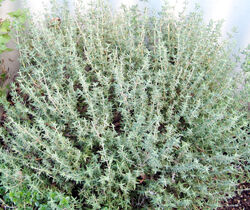Botrytis cinerea, commonly known as gray mold, is a fungal disease that can severely affect thyme and other herbaceous plants. This disease thrives in cool, damp environments and can lead to significant plant damage if not addressed promptly. Here are ten early signs that your thyme may be suffering from botrytis:
- Wilting Leaves: One of the first symptoms of botrytis is wilting. If your thyme plants suddenly appear droopy or limp, it could be an indication of infection, as the fungus disrupts the plant’s ability to take up water.
- Brown or Grayish Spots: Look for small, brown or grayish spots on the leaves. These spots can gradually enlarge, leading to leaf necrosis, which is a sign that the fungus is spreading.
- Fuzzy Growth: The presence of a gray, fuzzy growth on the leaves or stems is a clear indicator of botrytis. This mold often appears in damp conditions and can spread rapidly if not controlled.
- Premature Leaf Drop: Affected thyme plants may start dropping leaves prematurely. If you notice a significant number of leaves falling off without a clear reason, it may be due to botrytis.
- Discolored Stems: In addition to leaf symptoms, check the stems for discoloration. Stems may appear darkened or water-soaked, indicating fungal infection.
- Poor Growth and Vigor: Affected plants often exhibit stunted growth. If your thyme isn’t thriving despite proper care, botrytis could be the culprit.
- Mushy Texture: As the infection progresses, leaves and stems can become soft and mushy. This is a result of the plant tissue breaking down due to the fungal invasion.
- Flower Blight: If your thyme plants are flowering, watch for blighted flowers. Infected blossoms may wilt, turn brown, and eventually decay, affecting overall plant health.
- Unpleasant Odor: A foul or musty smell around your thyme plants can indicate the presence of botrytis. This odor arises from the decay of plant tissue due to the fungal infection.
- Localized Patches of Rot: In severe cases, you may observe localized patches of rot on leaves or stems. These areas will typically appear brown and may feel wet to the touch.
Prevention and Treatment
To manage botrytis in thyme, consider the following strategies:
- Improve Air Circulation: Ensure your thyme plants are spaced adequately to promote airflow, reducing humidity levels that favor fungal growth.
- Watering Practices: Avoid overhead watering and ensure the soil drains well. Watering early in the day allows moisture to evaporate before evening.
- Prune Infected Areas: Remove and dispose of any infected leaves or stems to prevent the spread of the fungus.
- Fungicide Application: If the infection is severe, consider using a fungicide labeled for use on herbs. Always follow the manufacturer’s instructions.
- Practice Crop Rotation: Avoid planting thyme in the same location year after year to minimize disease recurrence.
By recognizing these early signs and taking proactive measures, you can help your thyme thrive and protect it from the detrimental effects of botrytis.
Join 'Farmers Mag' WhatsApp Channel
Get the latest Farming news and tips delivered straight to your WhatsApp
CLICK HERE TO JOIN






